Kharkov battle. Forced surrender of Kharkov in October 1941 year
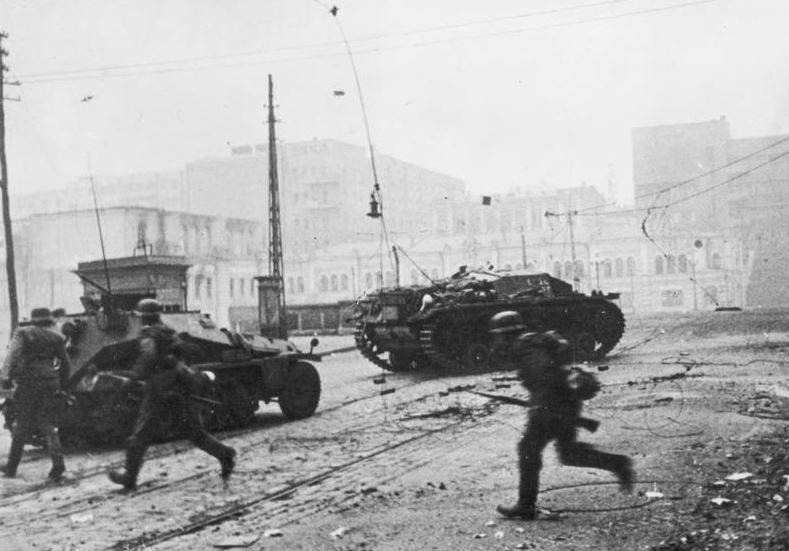
The strategic importance of Kharkov
What was Kharkov like by the fall of 1941? By its industrial, transit and human potential, Kharkov was the third city after Moscow and Leningrad and the largest city of the USSR occupied by the Wehrmacht during the war years. Kharkov was the largest industrial center of the Soviet Union, primarily heavy engineering, for example, here at the factory number 183 before the war, the T-34 tank was developed and mass-produced.
The city was also the largest strategic junction of railways, roads and air routes, passing along the directions west - east and north - south and in its significance was almost equal to the Moscow transport hub. The railway junction of Kharkov connected the central regions of the USSR with the Crimea, the Caucasus, Dnieper and Donbass. Kharkov provided a quick transfer of troops in both frontal and rocky directions of the front.
Before the war, there were 900 thousand people living in Kharkov (only 846 thousand in Kiev), by the end of August 1941, the population had grown to one and a half million due to refugees and wounded.
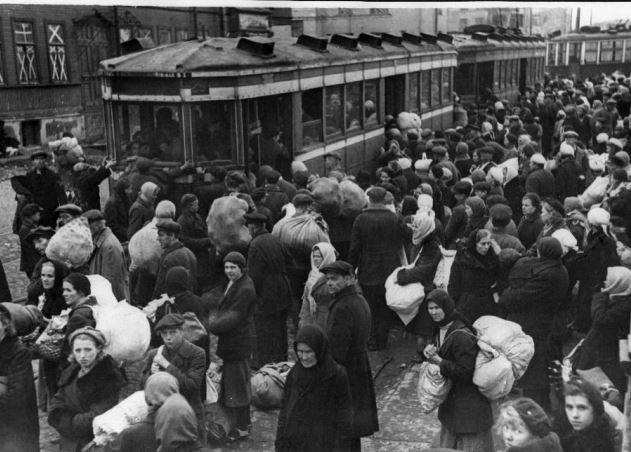
The defensive line of Kharkov was part of the defense system of the South-Western Front, which suffered two catastrophic defeats in July – September 1941. Under Uman’s, on 7 of August the 6 and 12 I armies of the South-Western Front were surrounded and destroyed, and on September 24 near Kiev the main forces of the South-Western Front consisting of five Soviet armies were surrounded and destroyed. Only in the "Uman boiler" 110 of thousands of Soviet troops were captured, and in the "Kiev boiler" an unprecedented number of our troops - 665 thousand were captured.
The southwestern front collapsed, and the Wehrmacht troops rushed to Kharkov in the resulting gap. The Germans already seized Poltava on September 18 of September, and Krasnograd on September 20 in the Kharkov region, in connection with which a ledge was formed towards Kharkov, and the fate of the city was in the balance.
Active offensive actions of our troops in the area of Krasnograd with the goal of liberating the city and cutting off the wedged enemy grouping continued until October 5 of the 1941 year and did not bring success, parts of the 52 and 44 army of the Wehrmacht were able to maintain their positions.
Since the end of July, the city and stations of the Kharkov railway junction were subjected to massive air raids. The main objectives were railway and military facilities, as well as finished goods warehouses of the most important enterprises. The factories themselves were virtually unaffected - the Germans sought to preserve the production base of the Kharkov industrial region for themselves.
Reasons to leave the city
In order to cover the South-Western Front, the Wehrmacht went on the offensive on September 27-30, conducting concerted actions against the Bryansk and Southern Fronts. First tank a group of Colonel General Kleist broke through the defenses of the weakened Southern Front in the Dnipropetrovsk region and entered the operational space. At the same time, the 2nd tank group of Colonel General Guderian, breaking through the defenses at the junction of the Bryansk and Southwestern fronts, launched an offensive in the Oryol direction. Three armies of the Bryansk Front were surrounded, and on October 3, German tanks broke into Orel, cutting off the strategic railway and the Moscow-Kharkov highway and creating an immediate threat to Moscow. On October 16, panic began in Moscow and the question of evacuating the capital was considered.
As a result of the Wehrmacht offensive, the troops of the South-Western Front were covered from both flanks, and the depth of coverage was 60 — 200 kilometers. Under these conditions, on October 6, the command of the Southwestern Front decided to withdraw the right-flank armies at 45 — 50 kilometers to the Sumy – Akhtyrka line in order to cover Belgorod and the northern approaches to Kharkov.
It was not possible to realize these plans, the 29th army corps of the Wehrmacht broke into Sumy, and the 51th captured Akhtyrka. The intended line of retreat was occupied by the enemy and Soviet troops retreated further east. Taking advantage of this, the 17 Army of the Wehrmacht hit the joint of our 21 and 38 Army and broke through the defenses. The right flank of the 38 Army was upset, the enemy of the 7 October captured Bogodukhov and created an immediate threat to Kharkov from the north.
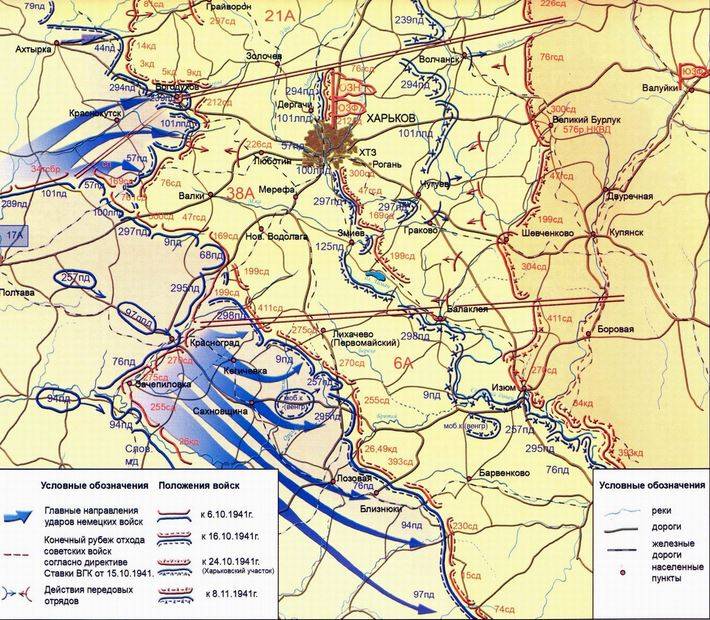
In the south, the Wehrmacht captured the most important railway junctions, Lozovaya and Bliznyuki, cutting the line along the Kharkov-Rostov line and taking control of the crossing on the Seversky Donets. The 11-th Wehrmacht army corps advanced along the Krasnograd-Kharkov highway, covering the city from the south. As a result, by October 15 of October 1941, units of the Wehrmacht approached Kharkov at a distance of 50 kilometers and could attack the city simultaneously from three converging directions.
Kharkov by that time was seriously preparing for defense, by October 20 the evacuation of the main industrial facilities from Kharkov was completed, 320 trains with 70 equipment of large plants were sent to the rear.
Outside the city, a defensive area was equipped with solid lines of trenches with a total length of up to 40 kilometers, more than 250 artillery and about 1000 machine-gun bunkers and dugouts were prepared, and up to three thousand anti-tank hedgehogs and gouges were installed.
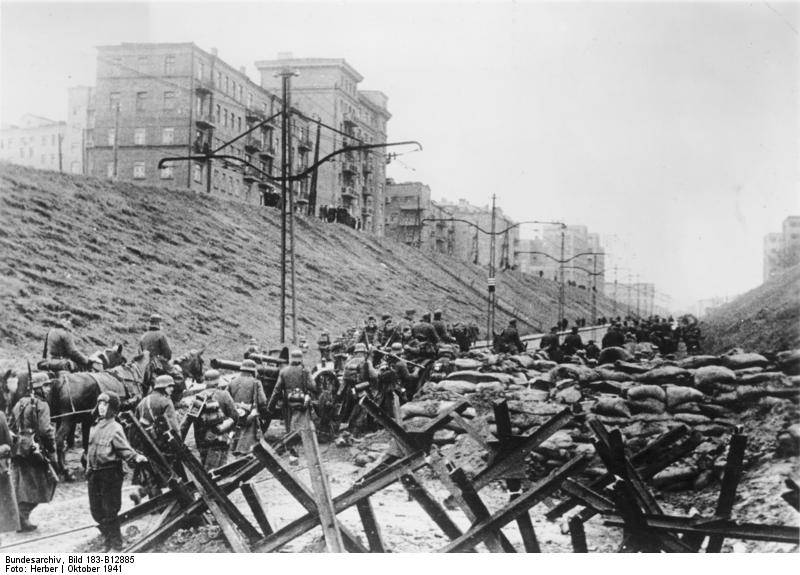
In the city itself, on the central streets, several hundred barricades were built with a total length of 16 thousand meters, using more than four hundred public transport cars. 43 city bridges were also mined; over ten bridges were destroyed in advance. According to experts, Kharkov was well prepared for defense, even in the environment it could hold out for a long time.
But all this was not required, the situation changed dramatically in the evening of October 15 with the arrival of the Directive No. 31 of the Supreme Command Headquarters in the front headquarters, in which the front was tasked with 17 — 30 of October to withdraw troops to the line Kastornaya - Stary Oskol - Novy Oskol - Valuyki - Kupyansk - Krasny Liman and withdraw at least six infantry divisions and two cavalry corps into the front line reserve. This meant that the troops of the front had to retreat from 80 to 200 kilometers and leave Kharkov, Belgorod and the Donetsk industrial region. The Stavka’s decision was caused by the catastrophic situation that developed in the defense zone of neighboring fronts and the rapid pace of the German offensive in the Moscow direction. In order for the troops located in the Kharkov region not to be in the next "cauldron", they were ordered to conduct only rear-guard battles, holding back the enemy until October 25 and then leave the city.
Kharkiv Mining Events
When preparing Kharkiv for defense in the event of the city surrendering there, on September 27 a group of Colonel Starinov was sent to conduct a series of special measures to mine defensive lines, disable industrial enterprises, railway and communications centers, bridges, communications, power plants and other important urban facilities economy by undermining, arson and mining. For this, more than 110 tons of explosives, tens of thousands of anti-tank and anti-personnel mines, as well as radio-controlled mines and mines with time-limited fuses were allocated.
In the Kharkov region, over 30 000 anti-tank and anti-personnel mines were installed, about 2000 delayed mines, about 1000 min-traps and over 5000 false mines. Bridges, roads, railways, airfields were mined. In the city, the central telephone exchange, power stations, water and sewer networks, the city central heating system, workshops and premises of all large enterprises of the city are mined and destroyed, and the remaining equipment is damaged or mined. Using radio-controlled mines, several mansions were also mined in the city center, where the deployment of German headquarters was supposed.
As a result of the measures taken, Kharkov was deprived of strategic importance as the largest industrial and transport center. The German command planned to use the industrial and transport capabilities of Kharkov for their own purposes. However, German experts noted the extreme degree of their destruction. Having made tremendous efforts to restore the infrastructure, they were able to restore the capabilities of the Kharkov transport hub only at the beginning of the 1942 of the year, and the industrial infrastructure for repairing Wehrmacht military equipment was restored only by May 1942 of the year.
Dozens of enemy trains, more than 75 vehicles, 28 units of armored vehicles, over 2300 enemy soldiers and officers were destroyed by mines installed during the departure from Kharkov, and on November 14 a mansion was blown up by radio signal from Voronezh, where the commandant of the city, General von Braun, was blown up.
It should be noted that the destruction of power supply systems, water and sewer networks and central heating systems left the residents remaining in the city in terrible conditions during the German occupation.
Aspect ratio on the eve of a city assault
Kharkov was preparing to surrender. According to the plans of the headquarters of the front, the 38-I army was to hold its positions at a distance 23-30 kilometers from Kharkov until October 40. However, these plans were frustrated; on October 20, units of the 55th Wehrmacht army corps captured the key defense point of Lyubotin, and advanced patrols reached the suburbs of Kharkov. Over the next day, due to uncoordinated actions to withdraw formations of the 38 army, the Wehrmacht captured the village of Dergachi north of Kharkov, and part of the 11 army army - the city of Zmiev south of Kharkov. Kharkov was in a semicircle, enveloped on three sides by the enemy.
For the direct defense of Kharkov, only garrison forces remained in the rear-guard battles, which were commanded by the regional military commander Maslov. On October 20, the command was transferred to the chief of defense of Kharkov, General Marshalkov. The garrison forces included the 216 rifle division (11 thousand people), the 57 separate NKVD brigade, the Kharkov regiment of the people's militia, separate battalions of local rifle troops and an armored detachment. The total number of troops of the garrison was 19 898 people with 120 guns and mortars and 47 tanks.
The 216th Infantry Division under the command of Colonel Makshanov was formed in early October from conscripts and servicemen of the rear units. The personnel of the division had no combat training, was not fired upon, and poorly prepared for fighting in the city, but was well armed. On the first day of fighting, the division commander showed cowardice, and he was replaced.
The Kharkov regiment of the people's militia and battalions of local rifle troops consisted of local residents of different age categories, enlisted as volunteers, and had a weak level of combat training, in addition, they were armed exclusively with rifles. A separate armored detachment included 47 units of obsolete armored vehicles: T-27, T-26 and T-35. Subsequent battles showed that only fighters of the NKVD brigade and the militia courageously fought, fighters of the 216 division were subject to panic, often fled the battlefield and deserted.
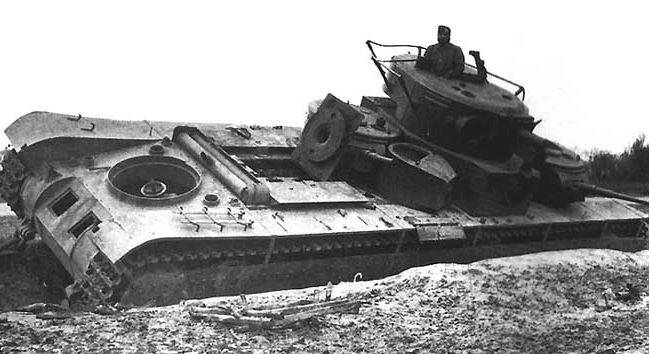
The Soviet troops were opposed by the 55 Army Corps under the command of the infantry general Erwin Firov, which was part of the 6 Army of the Wehrmacht under the command of Field Marshal Walter von Reichenau. The 101 light and 239 infantry divisions were reassigned to the corps, and heavy artillery units were also assigned. The offensive was to be carried out by the forces of three divisions, another division was in reserve. The main blow was delivered by the 57th Infantry Division, which carried out a frontal attack from the western direction with the support of units of the 101th and 100th Light Infantry Divisions, advancing from the north and south.
Rear Guard fights in Kharkov
The troops of the Wehrmacht 19 October almost unhindered from the west occupied the suburban line of defense. To eliminate this protrusion, the commander of the 38th Army ordered the 216th Rifle Division, the main unit of the Kharkov garrison, to advance from the city to the suburb of Perezhechnoye. The division, making a march at night, became upset and lost its combat effectiveness, and one of the regiments got lost and was found only after a day and a half, moreover, during the marches, up to 30% of the personnel deserted. After the first nomination order, a few hours later another order was received - to return to the starting position. As a result, the division, not taking up frontiers in the suburbs, returned to its original position. By the end of October 20, German troops reached the city outskirts of Kharkov, and the Soviet units did not have a solid line of defense.
Under these conditions, the command of the 38 Army takes over the direct leadership of the defense of the city, subjugating the headquarters of the defense of Kharkov, headed by General Marshalkov. In practice, this led to the fact that the units defending the city sometimes received conflicting orders from two command centers at the same time - the army headquarters and the headquarters of the Kharkov garrison.
On October 22, unexpectedly for the enemy, Soviet troops launched a counterattack by the forces of the 57th NKVD brigade and two regiments of the 216th rifle division in the direction of Kuryazh - Pesochin. During the day, protracted battles continued, but by evening the Soviet troops retreated to their original positions.
On the morning of October 23, German troops launched an offensive from the west and entrenched in the residential neighborhoods of the New Bavaria region. At noon, the main forces of the 57 Infantry Division went on the offensive. Slowly moving along the city streets, assault groups, overcoming the barricades, ditches and minefields built at each intersection, reached the railway line in the evening.
Attempts to separate parts of the Wehrmacht to bypass the city and break into it from the north along the Belgorod highway were suppressed by militia units at defensive lines in Sokolniki.
As a result of the first day of fighting, German troops managed to capture the western regions of Kharkov and reach the railroad, and in some sections and overcome it. Under these conditions, fearing encirclement, the commander of the 216th Infantry Division decided to withdraw his units to the eastern shore of Lopani, taking the second line of defense. Having learned about this, the command of the 38 Army canceled the withdrawal order and ordered the next day to counterattack the enemy from the western part of Kharkov. However, Soviet troops by this time had already crossed the river.
In general, the first day of fighting organized defense of the city did not work. Without proper combat training, the Soviet units immediately after the enemy managed to break into its western outskirts, panicked and hastily retreated to its center. Due to the lack of necessary means of communication and poorly organized interaction between units and subunits, the command and defense headquarters almost completely lost control over the actions of the troops in the first hours.
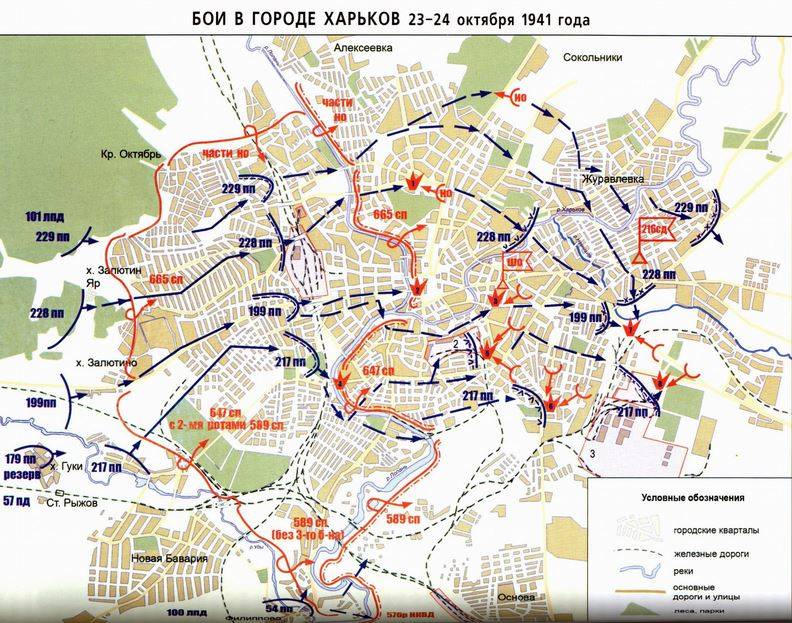
On the morning of October 24 1941, German troops occupied the city blocks between the railway and the river. Parts of the Wehrmacht also reached the area of the Balashovka and Levada railway stations and adjacent industrial enterprises. Having forced the Lopan River, the units of the 101 Light Division launched an offensive against the aircraft factory and on the central square of Dzerzhinsky. Fierce battles unfolded on Dzerzhinsky Square, where part of the people's militia kept the defenses under the onslaught of superior enemy forces for more than five hours. Parts of the 57 NKVD brigade, which were fixed in the area of Osnova station, were still stubbornly defending themselves.
By three o'clock in the afternoon, German troops captured the central regions of Kharkov. Resistance began to be focal in nature by the forces of disparate separate units and detachments. By the evening of October 24, parts of the Wehrmacht reached the eastern outskirts of Kharkov, and the remnants of the garrison began to move east. The withdrawal order was given by the commander of the 216th Infantry Division, Makshanov, who was dismissed from the post already in the morning on the orders of the army commander, but since the division headquarters had no contact with the army headquarters, the latter continued to lead the troops during the fighting for the city. The new division commander, brigade commander Zhmachenko, managed to find and reassign himself only two battalions. Until October 27, the division was actually controlled by two centers.
Formation of a new line of defense
The withdrawal of Soviet troops was carried out in the conditions of roads wet with rains. Fuel for equipment was running out, it had to be delivered in buckets. On the night of 25 in October, the commander of the garrison forces, Major General Marshalkov and the brigade commander Zhmachenko, on possible routes of withdrawal of the troops, several special barrage units were put up, whose duties were to detain the troops leaving the city. By morning, the units assembled overnight, with forces of up to two regiments, Soviet troops defended themselves in the area of the tractor factory, located outside the city limits. On the night of October 25 on October 26, Soviet troops withdrew beyond the Seversky Donets River, and Belgorod was also surrendered on October 24. While the formations of the 38 Army held back the enemy in the Kharkov direction, the remaining armies of the Southwestern Front continued to withdraw.
The main forces of the October 27 front held the defenses along the Seversky Donets. By the end of October, German troops, having created several bridgeheads on the eastern shore, switched to defense. The command of the Southwestern Front decided to stop the withdrawal of troops and go on the defensive in the Tim - Balakleya - Izium section and further along the Seversky Donets River. This configuration of the front line allowed us to prepare for further operations with the goal of liberating Kharkov.
In October, the German command did not set out to squeeze out Soviet troops, but to encompass a grouping of the Southwestern Front with the subsequent possibility of encircling due to deep penetrating attacks. After the development of the German offensive and the defeat of neighboring fronts, the troops of the Southwestern Front found themselves in a kind of ledge, which could lead to a repetition of the "Kiev boiler." Under these conditions, the Stavka’s decision to abandon the Kharkov industrial region, part of the Donbass and withdrawal of troops was, apparently, the only correct one. In the second half of October 1941, all the actions of the Soviet troops, including the direct defense of Kharkov, were strictly linked to the schedule for withdrawing formations of the South-Western Front.
Considering that by the end of October the troops of the Southwestern Front had moved to a solid defense at the lines designated by the Headquarters and the enemy did not show activity in this sector, the Soviet command found the results of the Kharkov operation as a whole satisfactory. The Soviet leadership was well aware of the significance of the loss of Kharkov and made serious efforts to return the strategically important city. In January 1942, the first attack on Kharkov began.
To be continued ...
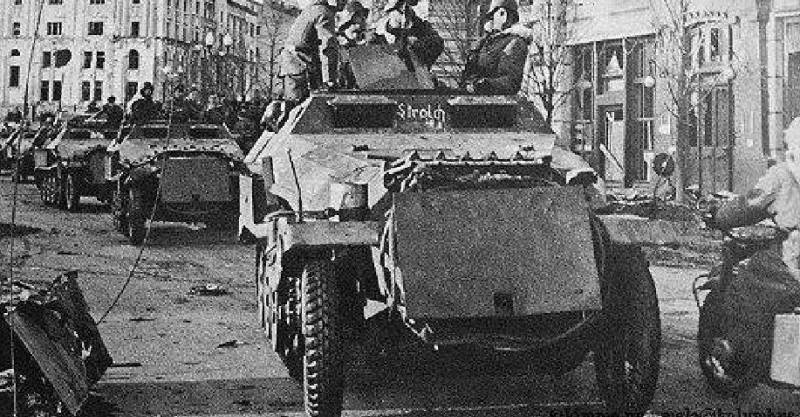
Information